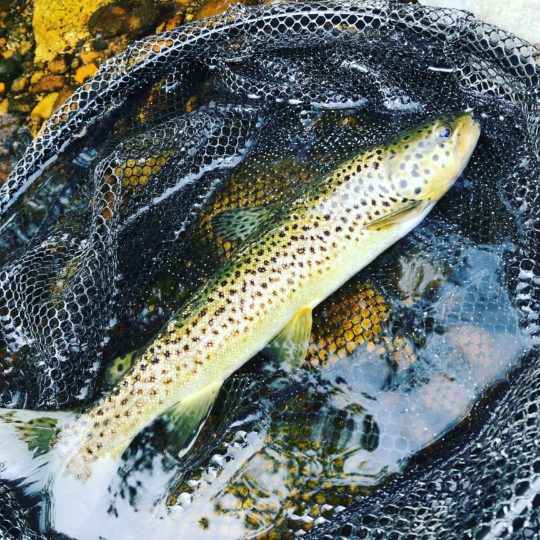TL;DR: If you’re in Southern New England, buy Tom Fuller’s book. Use Google Maps. Build your visual memory.
As you know, we have written quite a few river overviews to feature waters that tend to be accessible, stocked and productive (link here).
I thought I’d share with you one person’s journey to find them. Your mileage may vary, but here’s what I did.
Step 1
I read Tom Fuller’s Trout Streams of Southern New England.
This book is incredible. For $16, it is like having a guide for many, many bodies of water.
Fuller features quite a few bodies of water and detailed write-ups on each of them. He even suggests parking spots and flies. It is very fun and exciting to read about so much opportunity around us.
It is how I started to fish the Millers, Nissitissit, Squanacook, Swift, Westfield and Farmington. It is a book that truly shares many treasures.
Step 2
I went to Google Maps. Using “street view” and “terrain view,” I tried to identify both potential fishy areas as well as parking spots. For the former, I identified structures, such as visible log jams, rocky areas and big bends in the river. For the latter, I looked for dirt pull outs; fishy areas tend to get attention, and the ground at good parking spots are worn down.
Step 3
Once at a new river, I take a look around. Trout tend to hang predictably in certain spots. Here are the main ones that have worked for me:
- Right in front of a rock in the soft pillow of water
- Where two currents meet, creating very broken water
- At the back end of a long run, where the water starts to quiet
- If the water is low, or there are many bugs, in the riffles
- In the winter, at very deep and quiet pools, where they hunker down
Step 4
Be willing to lose flies. One time, in Montana, I went nymphing with a seasoned angler. He added about 3x the split shot I did (this was before I learned to tightline). He lost flies, but he landed a lot more fish than I did. So, add more weight than you think you need. Over time, you’ll get a better grip on this.
And, if you tie your own, some of the best patterns are cheap and easy to make. Some of the best patterns for me have been the Walt’s Worm and Sexy Walt’s.
Step 5
Keep remembering where you have found fish. It’s hard to explain, but it becomes a pattern-recognition game. As you spend time on the water, you’ll recognize certain spots as fishy.
Two examples. First, I a few weekends ago hit a new stretch of the Farmington (post here). Flows were the lowest I’ve ever seen it there, and there was a ton of snot grass everywhere. It looked very discouraging.
But, I had seen some fishy areas on Google Maps and just started to walk along the bank. Eventually, I saw a big rock in the middle of the water. I recalled a low-flow time at the Westfield River and how a fish out of nowhere appeared out from under a big rock and took my fly.
So, I tightlined nymphs around that rock. As Lady Luck would have it, I had three takes, and I landed two of them. Here’s one.

Second example. Two runs below the rock, I saw three currents merge into one, creating a lot of broken water for about five feet. It reminded me of an incredible spot up river, and one that I fish often; it is a very short and narrow trench that is the result of multiple currents combining into one. There, the currents collide, the water slows, and there is a very healthy bubble line under which is a deeper trench where good-sized fish hang out.
At this new spot, I threw out a Red Dart. A very good 15.5″ brown came to the net and ended up being the biggest fish of the weekend.
So, that’s what I do to find new water. Hope this post is helpful to you! To catch a fish at a spot that you’ve found with a fly that you’ve tied is a truly amazing sensation.
If you liked this post, please share it with a friend! Thanks!
Discover more from BlogFlyFish.com
Subscribe to get the latest posts sent to your email.

These are good tips Jo! They definitely came in handy exploring new water yesterday.
Thank you! Nice of you to say so!